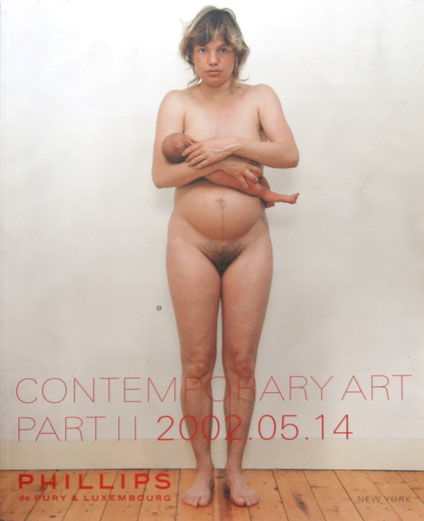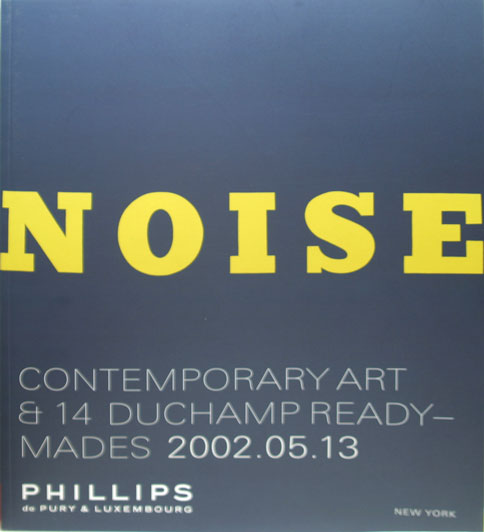 It so happened the last time I was in Chelsea that I wandered by Gallery Henoch -- rapidly becoming one of my favorite places -- and found they were clearing out several years' accumulation of auction catalogs. I grabbed a couple, just because they were free and seemed neat. Also, one had a photo of a nude woman nursing a baby on the front, and I just love moms when they're naked.
It so happened the last time I was in Chelsea that I wandered by Gallery Henoch -- rapidly becoming one of my favorite places -- and found they were clearing out several years' accumulation of auction catalogs. I grabbed a couple, just because they were free and seemed neat. Also, one had a photo of a nude woman nursing a baby on the front, and I just love moms when they're naked.
The first thing I noticed was that these catalogs were hilariously well-produced, considering they were given away to be thrown away. The cost of printing one run of these catalogs would probably keep a mid-level artist in paints and beer for a year. I understand that, given what auction houses make, this sum is simply a tiny drop in a very large, very full bucket. But still, I can't help but wonder how it would change the art world if, instead of giving these vast sums out to printing companies, auction houses gave them out to artists whose work they're not selling -- not yet, anyway. Well, for all I know, auction houses support arts grants and organizations to the tune of zillions of euros every year. For all I know.
 The next thing I noticed was that one of the catalogs, to my surprise, was for an auction including 14 of Marcel Duchamp's readymades. It seems that Phillips de Pury & Luxembourg sold Arturo Schwarz's collection of Duchamp back in 2002. Well, most of it. Not every piece sold.
The next thing I noticed was that one of the catalogs, to my surprise, was for an auction including 14 of Marcel Duchamp's readymades. It seems that Phillips de Pury & Luxembourg sold Arturo Schwarz's collection of Duchamp back in 2002. Well, most of it. Not every piece sold.
I've made it clear in previous posts that I am a philistine. A largely uneducated philistine, at least where art is concerned. I've never had a formal class in art or art history and everything I know I learned on my own. Therefore I was in the perfect position to learn something about Duchamp's readymades, which have been so influential in late 20th century art.
What I learned was this: Half of the auction entries begin, "The original, produced in 191x, was lost; the present lot was produced under the artist's supervision from photographs of the original."
The original was lost. In other words, the original was treated as a regular object by an unwitting person, not as the work of art into which it had been magically transformed, and thrown out. And, in point of fact, it was probably treated like a regular object by Duchamp himself, or someone he knew. His Bottle Rack he left behind in Paris. He wrote to his sister from New York telling her he would cause the rack to become art at a distance; she, showing far more sense than an entire generation of artists and critics, apparently knew he was full of crap and tossed it in the 1916 Parisian equivalent of a dumpster.
Now, because half of these readymades were "lost" -- Duchamp's two most famous, Fountain and Bicycle Wheel in particular -- and the others already owned by other people, he had to have each one of these "readymades" carefully crafted as entirely handmade reproductions. Yes: The urinal you can see in any one of several museums is, in fact, not a urinal at all, but a sculpture of a urinal. That is, it's a mass-produced item reproduced as a one-of-a-kind sculpture. The catalog shows the detailed schematics drawn up for each item, and there's even a photo of the urinal-in-progress.
Duchamp himself writes about his readymades: "A point that I want very much to establish is that the choice of these 'readymades' was never dictated by aesthetic delectation. The choice was based on a reaction of visual indifference with at the same time a total absence of good or bad taste...in fact a complete anaesthesia."
One of the readymades on the block, Trebuchet (Trap), wasn't even originally bought to be a readymade. It was bought to be an actual coat rack. But Duchamp never got around to putting it up and he kept tripping over it in his studio. Finally he nailed it to the floor. That made it art. Except at some point he must have chucked it in the trash, because the original is "lost."
So to sum up, Duchamp would take an object he found somewhere -- without regard to whether it was pretty or utilitarian or anything at all -- maybe write some gibberish on it, keep it around his studio for a bit, then throw it away. And then in 1964, he had a bunch of new ones made. Which for some reason now reside in museums.
I'm willing to accept Duchamp's work as a large practical joke, except it seems no one has gotten it. I thought Fountain was a fairly obvious jest, and that was before I'd heard its full story. Every time I hear another detail in the Duchamp saga, I find it even more blatantly ridiculous, and I end up even sadder than I was.
Do you think this essay makes me look like an idiot? A rube? An uneducated bozo proud of his ignorance?
Good. Then I succeeded.
By the way, I've declared these two catalogs works of art. Anyone want to buy one? I'll even sign it.


Leave a comment